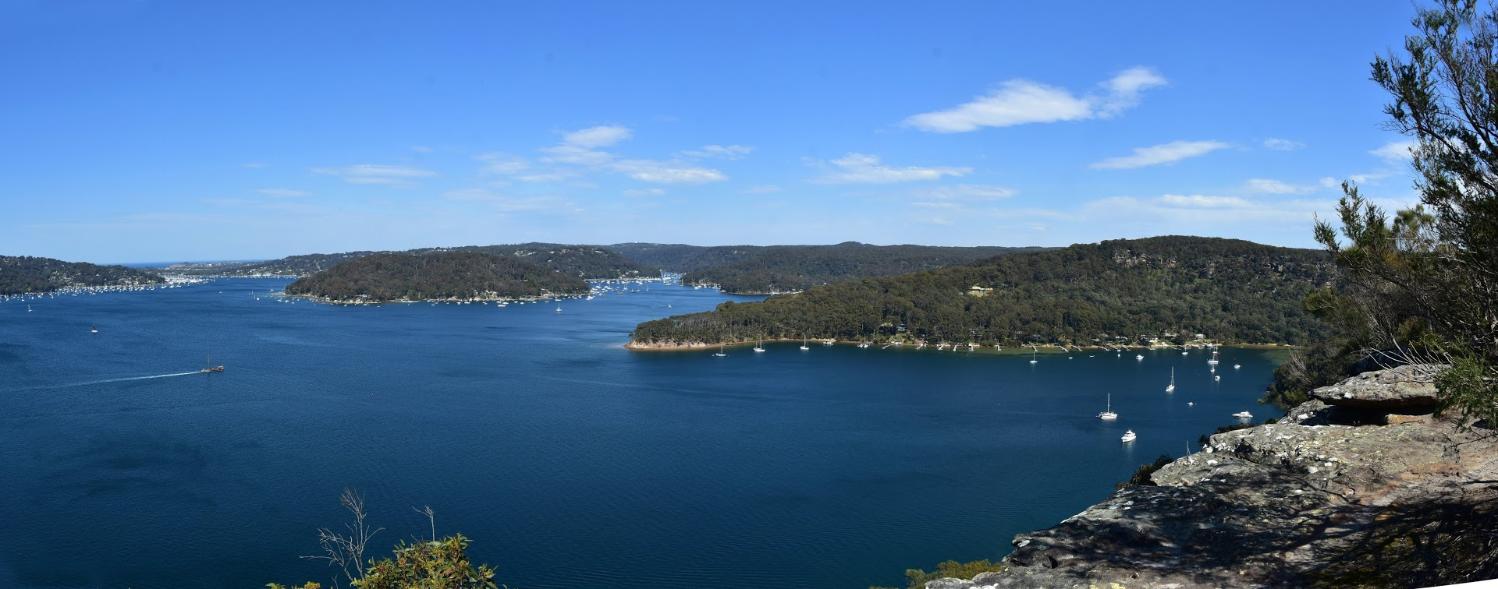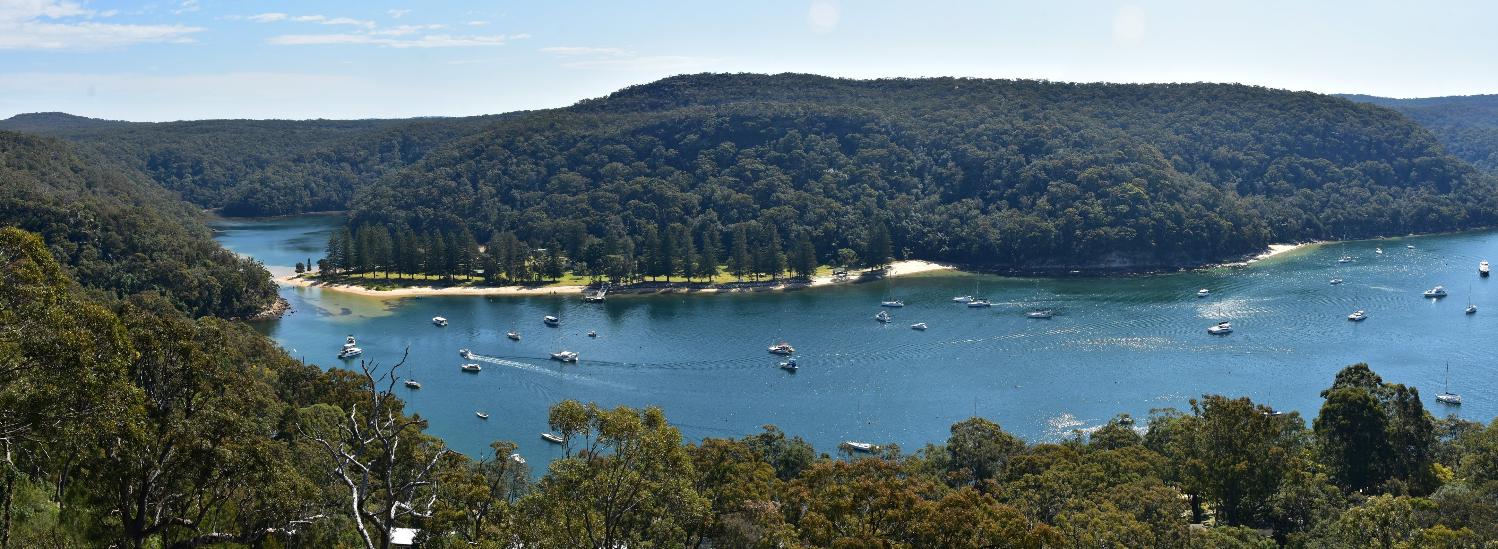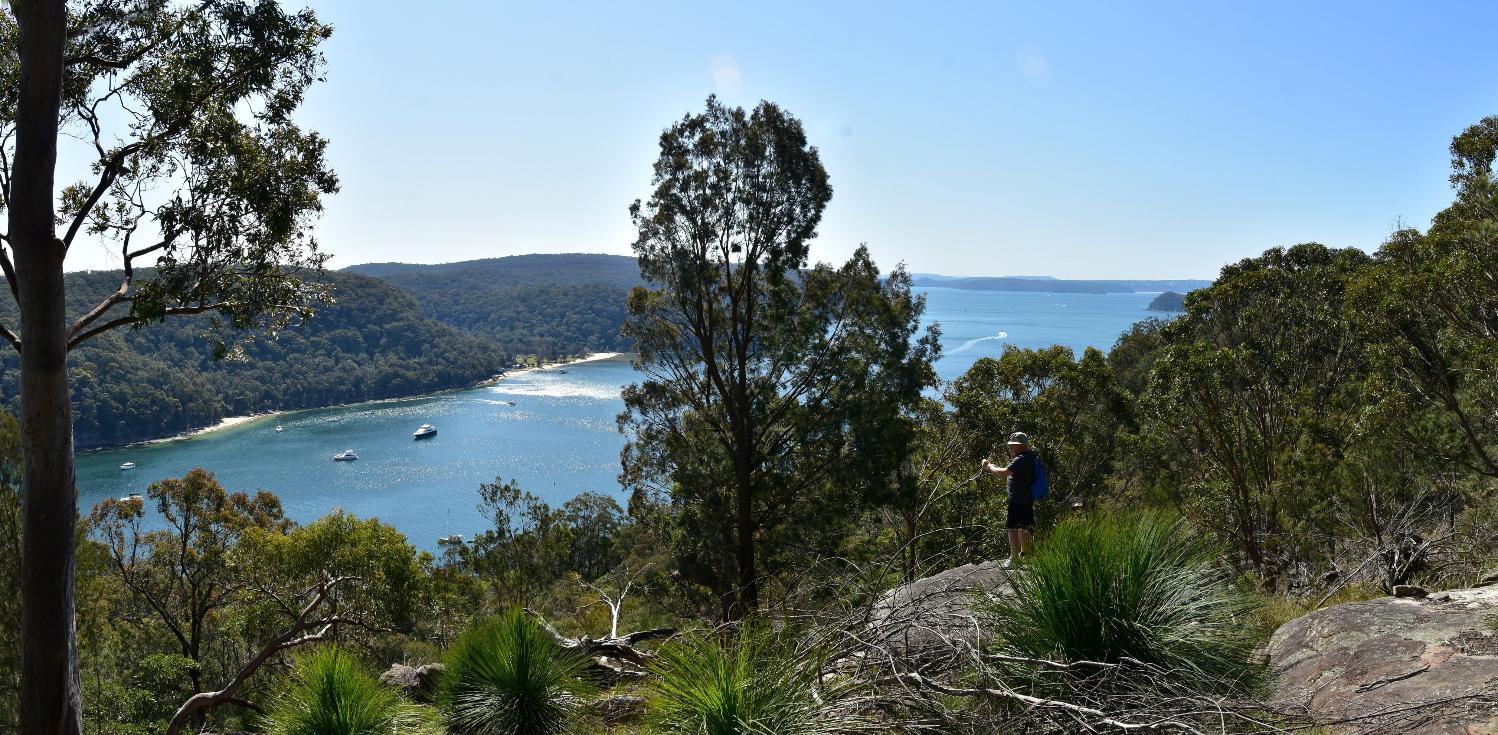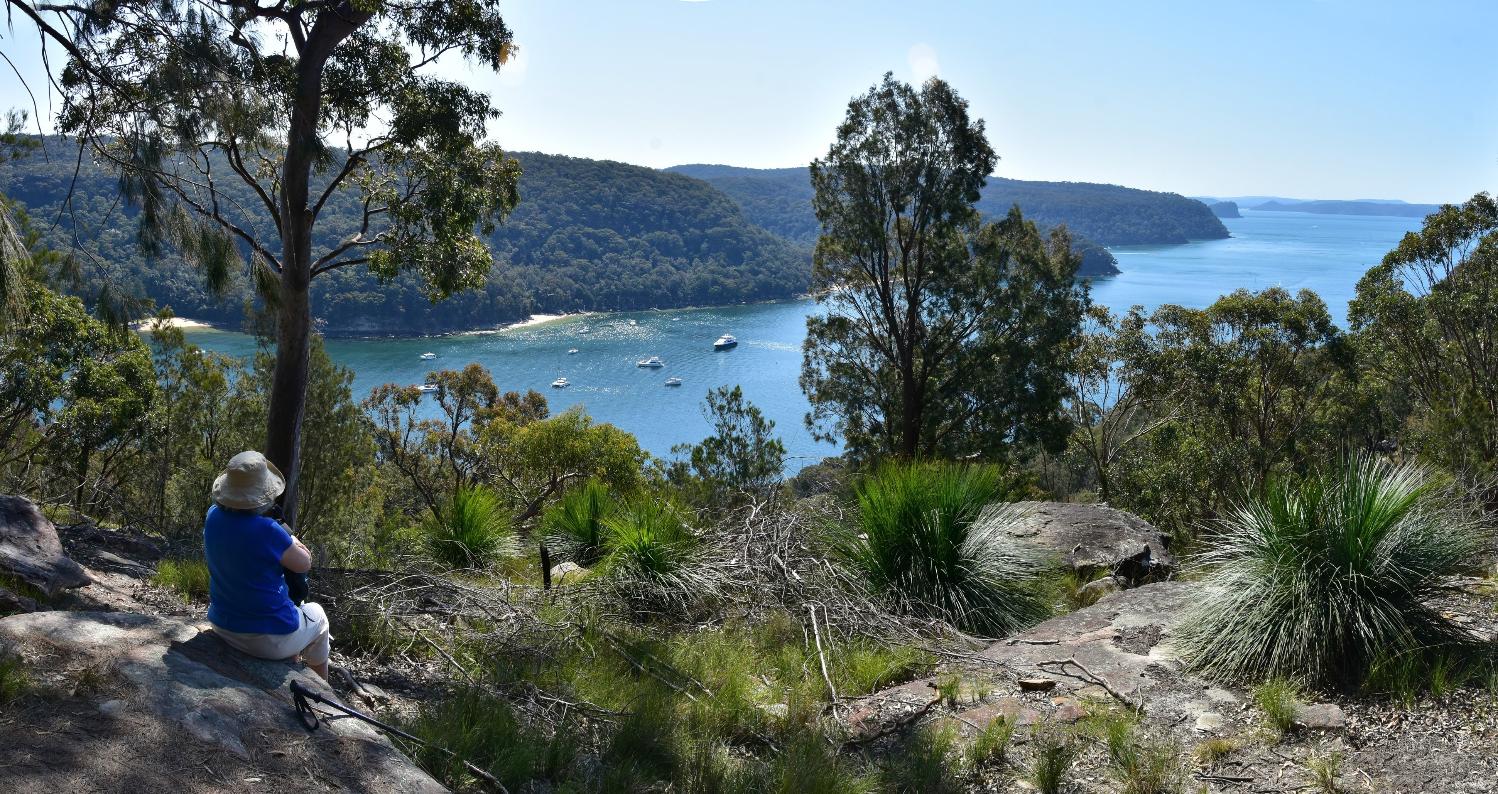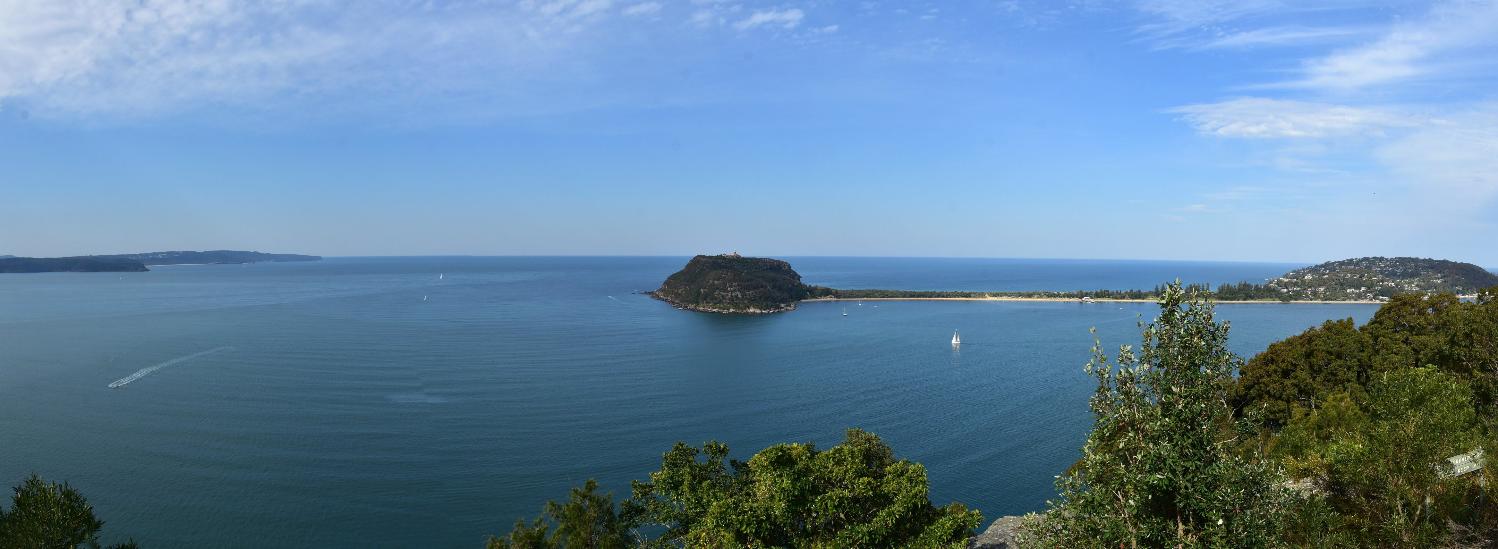A long and easy walk, the Bairne walking track takes you to 2 scenic lookouts, with stunning views over Pittwater and The Basin, in Ku-ring-gai Chase National Park. Past Artists of the Month, Joe Mills, Cantiamo choirs' Glenys and Kevin Murray enjoyed the fresh air and sunshine of this beautiful place, alive with flowers and birds, on Thursday September 3rd, 2020.
This walk, with a distance of 9.6km return, follows a track along the ridgelines from which some of the best views in Ku-ring-gai Chase National Park of Pittwater can be accessed. A spectacular walk in Spring, the wildflowers make for excellent birdwatching.
The Bairne walking track starts from West Head Road, passing through heathlands of banksia, boronia and grevillea. Look for nectar-loving yellow-faced honeyeaters and the vibrant variegated wren. After around 2.5km, you'll reach an intersection. Head south for 1km to Towlers Bay lookout, for magnificent views of Towlers Bay and Pittwater - along with the Sea Eagles that live here.
Return to the intersection and follow Soldiers Point track around 1.3km to the lookout, where you'll have a brilliant view of The Basin and northern Pittwater.
The Bairne Track was named after the historical Bairne Trigonometric Station, constructed near the trail in 1882 by Thomas Charles Swannell, who would chosen the name “Bairne” according to some sources.
History pages available:
Mr. Swannell was a Surveyor and the pioneer overseer of the NSW Trigonometrical Survey at that time, receiving, according to one article £3 10s a week for this work. Mr. Swanell was declared a bankrupt in 1895. His health deteriorated, leading to a heart attack a few years later. His son Fred, a popular Veterinarian in the Parramatta-Windsor area, also died of a heart condition in 1936.
Obituary.
WE have to record the death of another of Windsor's residents in the person of Mr Thomas Charles Swannell, who died rather suddenly on Sunday last, at his residence, Newtown, Windsor. Deceased was born at Bedfordshire, England, and was in his 58th year. He had resided in the district for the past nine years, during which time he held the position of Forest Ranger. On Saturday morning last the deceased drove to Pitt Town, at which place he took ill and had to be driven home Dr. Callaghan was summoned, and did all that was possible, and deceased appeared to be getting better. On Sunday morning, however, he took a sudden change, and about 6 p.m. he succumbed, the cause of death being paralysis of the heart, The funeral took place on Tuesday afternoon. Leaving the house at 3 o'clock, the cortege, which was a large one, wended its way to St. Matthew's Church of England Cemetery, where the interment took place. The Rev S G Fielding officiated, and Mr J Primrose carried out the funeral arrangements. Obituary. (1897, September 4). Windsor and Richmond Gazette (NSW : 1888 - 1961), p. 9. Retrieved from http://nla.gov.au/nla.news-article72552856
MR. FRED SWANNELL Death Last Saturday PROMINENT VETERINARY SURGEON
Mr. Fredl Swannell, the well-known Parramatta veterinary surgeon, died last Saturday in the Parramatta private hospital, after an illness extending over a period of nine months. His heart was affected. Mr. Swannell had practised his profession at Parramatta for 34 years, and prior to the march of the motor was known, to practically every resident of the County of Cumberland. He was not ed for his professional skill, and his services were much in demand. Not only was he an expert in the treatment of stock, he was regarded as a high authority on dog's ailments.
Born in Bungendore 59 years ago, he was the son of the late Thomas Charles Swannell, surveyor. He was educated at Richmond and the Hawkesbury Agricultural College, gaining his diploma at the college. During the South African War he was veterinary surgeon on one of the White Star transport vessels, making in all seven trips from Australia to Durban. He was also at the scene of action. When the Boxer outbreak was in progress in China he was also connected with the transport of horses for military purposes. He went on active service during the Great War, serving with the Light Horse in Palestine from 1916 to the signing of the Armistice. He was one of the first two men to enter Jerusalem when that city was taken by the British forces.
At the conclusion of the war Mr. Swannell resumed practice at Parra matta and continued his activities in that sphere almost until his death. He was a conspicuos figure in the show ring, both as an official and exhibitor. He was honorary veterinary surgeon to Blacktown, Castle Hill, Granville, and Parramatta show societies. At the ''"Royal" he carried of many prizes, particularly in the section for cobs. His services as judge, both of cattle and horses, were frequently requisitioned.
Many years ago, Mr. Swannell was veterinary surgeon in charge of the most valuable collection of blood stock ever sent to the East. The consignment was for the Japanese Government and included many prominent racehorses including a prominent Rosehill equine, Long Tom. At different periods he owned a number of racehorses, the last to carry his colors being Foudroyant, a winner at Randwick and elsewhere. About a year ago he built fine new stables on his property at Glebe-street, Parramatta, for Mr. Maurice Anderson, Foudroyant's mentor.
Mr. Swannell was well-known in Masonic circles, having been a member of Lodge Sir Walter Scott, Granville, for many years.
He is survived by his widow, two sons, Messrs. Kenneth and Robert Swannell, and a daughter, Mrs. C. Moore. Mr. Roland Swannell (Concord) is a brother of the deceased and Mrs. E.B. Pottie and Sister N. Swannell (Albury) are sisters. Sister Swannell also served in the Great War.
The funeral took place on Monday afternoon and prior to the cortege leaving for the Crematorium, Rookwood, a service was conducted at the mortuary parlor of Messrs. Metcalfe and Morris, Parramatta, by Rev. Roberts, of St. John's, Parramatta. The chief mourners were deceased's relatives.
Others present included Councillor A. Morehead, Messrs. E. T. Dolan (president Veterinary Surgeons' Association), T. B. Baker, J. Hicks (president Blacktown Show), W. H. Simpson (president Granville Show), H. E. Haddrill (president Parramatta Show), T. Perry, .T. Stewart, F.. Dncueum, R. Anderson, E . Howett, S. Hanscombe, A. L.'Bates, G. Mi. Pilgrim, 'H. Thomas, F. Smith, F. Madden (secretary N.S.W. Dairymnen's Association), P. A. Holmes, S. Evasis, E. Sell, H. R. Mathor (secretary Granville Show), W. Down, E. B. Dawes, A. Graham, T. . W.'. Cooper, S. Smith, - Strang, E. Budins -. noeble, H. Mason, W. A. Ross, I..E. Quigloy (''Cumber land Argus"), Bruce Pottie, S. Marks, J. Sands, R. Thompson, Mrs. T. Brown, Mr. and Mrs. W. J. Fleet, Mr. and Mrs. C. H. Leabeater, Detective and Mrs.J. McCarthy, Mrs. Gleeson, Miss Pitt, Miss N Harris, and others. Among the many floral tributes forwarded was a beautiful wreath from the Rosehill trainers. The funeral was conducted by Messrs. Metcalfe and Morris, Ltd. MR. FRED SWANNELL (1936, January 2). The Cumberland Argus and Fruitgrowers Advocate (Parramatta, NSW : 1888 - 1950), p. 4. Retrieved from http://nla.gov.au/nla.news-article104682807
The track was constructed for walkers and for Rangers to monitor the taking of Australian bushflowers prior to legislation that meant local people could be Honorary Rangers and keep an eye on the bush.
Visit: A Bunch Of Wildflowers: Historical Spring September Songs
KURING-GAI CHASE. The executive trustees of Kuring-gai Chase, with Mr. J. Garrard, chairman, made their periodical inspection of the Chase on Saturday. At Pittwater the local progress committee waited upon them for some improvements in that section, such as shelter accommodation and water supply in connection with the magnificent view and track from the "Lookout"(500 feet) above Lovett's Bay. A large number of visitors are said to be attracted to the western side of Pittwater, and the view overlooking the broken indentations of Pittwater is said to be equal to anything in the way of marine views to be found in the world. A request was also made for a track from Pittwater to the head of Coal and Candle creeks, Cowan. Further, that a landing jetty be placed for excursionists at Chinaman's Beach, on the western side of Pittwater. The trustees have the requests under consideration.
Several improvements have recently been made which will be found very convenient by visitors to the Chase. They include the erection of a new rustic shelter shed at Kuring-gai Point, in the Bobbin section, together with water supply. Some of the commodious caves which are largely used by camping parties have been made more comfortable for occupation by levelling and cementing the floors, etc.
Between Umbrella and Peach Tree caves a dam has been put in to secure a water supply, and a pipe line has been laid to the water’s edge, so as to suit boating parties.The various properties of the Chase were inspected, and generally found to be in good order. The picturesque surroundings of both Cowan and Pittwater were found to be most attractive, and there is a prospect of a large number of visitors in the present season. The fishing is also said to be improving with the warmer weather. KURING-GAI CHASE. (1908, October 28). The Sydney Morning Herald (NSW : 1842 - 1954), p. 4. Retrieved from http://nla.gov.au/nla.news-article15009620
The park has several of these trigonometrical stations:
Department of Lands,
Sydney, 4th November. 1893.
RESERVES FROM SALE FOR TRIGONOMETRICAL PURPOSES.
HIS Excellency the Governor, with the advice of the Executive Council, directs it to be notified that, in pursuance of the provisions of the 101st section of the Crown Lands Act of 1884, the land hereunder described shall be reserved from sale for trigonometrical purposes, and is hereby reserved accordingly.
HENRY COPELAND.
Metropolitan Land District.
No. 18,967. County of Cumberland, parish of Broken Bay, at Bairne Trigonometrical Station, containing an area of 10 acres. The Crown Lands within the following boundaries : Commencing at a point bearing north 45 degrees east 7 chains 7 links from Bairne Trigonometrical Station ; and bounded thence by a line bearing south 10 chains; thence by a line west 10 chains ; thence by a line north 10 chains; and thence by a line east 10 chains, to the point of commencement. [Ms. 98-8,051 Dep ]
No. 18,988. County of Cumberland, parish of Broken Bay, at Arthur Trigonometrical Station, containing an area of 4 acres. The Crown Lands within the following boundaries : Commencing at a point bearing north 45 degrees east 4 chains 47 1/2 links from Arthur Trigonometrical Station ; and bounded thence by a line south 6 chains 33 links ; thence by a line west 6 chains 33 links ; thence by a lino north 6 chains 33 links j and thence by a line east 6 chains 33 links, to the point of commencement. [Ms. 93-8,052 Dep.]
No. 18,969. County of Cumberland, parish of Broken Bay, at Cowan Trigonometrical Station, containing an area of 4 acres. The Crown Lands within the following boundaries: Commencing at a point bearing north 45 degrees east 4 chains 47 3/4 links from Cowan Trigonometrical Station ; and bounded thence by a line south 6 chains 33 links ; thence by a line west 6 chains 33 links; thence by a line north 6 chains 33 links ; and thence by a line east 6 chains 33 links, to the point of commencement. [Ms. 93-8,052 Dep.]
No. 18,970. County of Cumberland, parish of Broken Bay, at Duffy Trigonometrical Station, containing an area of 4 acres. The Crown Lands within the following boundaries : Commencing at a point bearing north 45 degrees east 4 chains 47 1/2 links from Duffy Trigonometrical Station; and bounded thence by a line south 6 chains 33 links ; thence by a line west 6 chains 33 links ; thence by a line north 6 chains 33 links ; and thence by a line east 6 chains 33 links, to the point of commencement. [Ms. 93-8,052 Dep. ]
No. 18,971. County of Cumberland, parish of Broken Bay, at Eva Trigonometrical Station, containing an area of 10 acres. The Crown Lands within the following boundaries : Commencing at a point bearing north 45 degrees east 7 chains 7 links from Eva Trigonometrical Station ; and bounded thence by a line bearing south 10 chains j thence by a line west 10 chains; thence by a line north 10 chains j and thence by a line east 10 chains, to the point of commencement. [Ms. 93-8,052 Dep.]
No. 18,972. County of Cumberland, parish of Broken Bay, at White Trigonometrical Station, containing an area of 5 acres. The Crown Lands within the following boundaries : Commencing south 7 chains 8 links;j thence by a line west 7 chains 8 links j thence by a line north 7 chains 8 links; and thence by a line east 7 chains 8 links, to the point of commencement. [Ms. 93-8,054 Dep.]
No. 18,973. County of Cumberland, parish of Broken Bay, at M'Carr Trigonometrical Station, containing an area of 4 acres. The Crown Lands within the following boundaries: Commencing at a point bearing north 45 degrees east 4 chains 47 1/2 links from M'Carr Trigonometrical Station j and bounded thence by a line south 6 chains 33 links; thence by a line west 6 chains 33 links; thence by a line north 6 chains 33 links, and thence by a line east 6 chains 33 links, to the point of commencement. [Ms. 93-8,055 Dep.]
No. 18,974. County of Cumberland, parish of Broken Bay, at Taber Trigonometrical Station, containing an area of 4 acres. The Crown Lands within the following boundaries: Commencing at a point bearing north 45 degrees east 4 chains 47£ links from Taber Trigonometrical Station; and bounded thence by a line bearing south 6 chains 33 links; thence by a line bearing west 6 chains 33 links j thence by a line bearing north 6 chains 33 links j and thence by a line east 6 chains 33 links, to the point of commencement. [Mb. 93-8,056 Dep.]
No. 18,975. County of Cumberland, parish of Broken Bay, at Roach Trigonometrical Station, containing an area of 10 acres. The Crown Lands within the following boundaries: Commencing at a point bearing north 45 degrees east 7 chains 7 links from Roach Trigonometrical Station j and bounded thence by a line south 10 chains ; thence by a line west 10 chains; thence by a line north 20 chains; thence by a line east 10 chains, to the point of commencement. [Ms. 93-8,057 Wep.]
No. 18,976. County of Cumberland, parish of Broken Bay, at Wilkins Trigonometrical Station, containing an area of 3 acres. The Crown Lands within the following boundaries: Commencing at a point bearing north 45 degrees east 3 chains 87 links from Wilkins Trigonometrical Station ; and bounded thence by a line bearing south 5 chains 48 links ; thence by a line bearing west 5 chains 48 links ; thence by a line bearing north 5 chains 48 links; and thence by a line bearing cast I chains 48 links, to the point of commencement. [Ms. 93-8,058 Dep.] RESERVES FROM SALE FOR TRIGONOMETRICAL PURPOSES. (
1893, November 4).
New South Wales Government Gazette (Sydney, NSW : 1832 - 1900), p. 8592. Retrieved from
http://nla.gov.au/nla.news-article220972597
The Trigonometrical Survey of New South Wales, as it was then known, commenced in 1867 with the selection of the first baseline at Lake George and continued with little interruption for almost 50 years until it was suspended for reasons of economy and war in 1916. By then, about one third of the State (mainly in the south-east) had been covered by a series of well-conditioned triangles of first and lower orders. The survey was resumed intermittently between the two World Wars with much of its progress attributable to the Royal Australian Survey Corps, particularly the connections to the Victorian and Queensland networks, and along the NSW North Coast.
Trig stations are the traditional backbone of a classical survey control network and form the primary or highest-order network, from which all other surveys are controlled. Trig stations come in a variety of forms and structures and usually consist of a primary monument or standpoint surrounded by witness or eccentric marks. The primary monument can take on a multitude of forms, ranging from survey pillars (concrete or steel) to plugs in stone underneath rock cairns or in rare cases galvanised iron (GI) pipes or stainless steel rods in soil. It should be noted that all CORSnet-NSW stations are also trig stations – these are known as ‘active’ trigs.
Department of Lands,
Sydney, 22nd May, 1886.
RESERVE from sale for military purposes.
HIS Excellency the Governor, with the advice of the Executive Council, directs it to be notified that, in pursuance of the provisions of the 101st section of the Crown Lands Act of 1894, the land specified in the Schedule appended hereto shall be reserved from sale for military purposes, and is hereby reserved accordingly.
HENRY COPELAND.
No. 149. County of Cumberland, parish of Broken Bay, area 3 acres 1 rood 20 perches. The Crown Lands within the following boundaries : Commencing at a peg bearing south 48 degrees 31 minutes east and distant 48 chains 74 links from trigonometrical station, "Bairne" ; and bounded thence on the east by a line bearing south 9 degrees 30 minutes east 7 chains 87 links to high-water mark on the shore of Fowler's Bay, Pittwater; thence on the south-west by that high-water mark north-westerly to a peg bearing south 80 degrees 30 minute3 west, from the point of commencement and thence on the north by a line bearing north 80 degrees 30 minutes east 6 chains 48 links to that point.
Shown on plan catalogued C. 884-2,030 Roll. Within the Metropolitan Land Board District. [Ms. 86-7,002] RESERVE FROM SALE FOR MILITARY PURPOSES. (
1886, May 22).
New South Wales Government Gazette (Sydney, NSW : 1832 - 1900), p. 3653. Retrieved from
http://nla.gov.au/nla.news-article221684917
Ku-ring-gai Chase National Park was declared in 1894, and is the second oldest national park in Australia, with the Royal National Park being the oldest. Following pressure from Eccleston Du Faur, to establish a "National Park for North Sydney", approximately 13,500 hectares, including not only land areas but also most of Cowan Water, was set aside in 1894 as Ku-ring-gai Chase and placed under the care, control and management of trustees. The park was named after its original inhabitants, an Aboriginal group called the Kuring-gai or Guringai, and called a "chase" to indicate it was an area of natural bush which was not enclosed by fences. Ku-ring-gai Chase became a national park with the proclamation of the National Parks and Wildlife Act in 1967. Additions to the park have made it 14,882 hectares in size.
VIEWS FROM THE HEIGHTS.
Setting out on the main inspection, the trustees left the houseboat by launch and visited the head of Smith's Crock, the head of Coal and Candle Creek, Jerusalem Bay, past Barrenjoey Lighthouse, Longnose Point, Pittwater, Lovett's Bay, and Towler's Bay. Here the climbing started. Almost overhead from the trustees' buildings, at Towler's Bay are to be seen great overhanging lodges of rock, called Perry's Lookout, after Mr. John Perry, a member of the trust. To reach this point, a very steep ascent had to be negotiated. Once at the top, the energy of the climbers was well rewarded. The view was simply magnificent. Far below, about ' 450ft., were the buildings, the wharves, the launches, and the sea. Intercepting the view downward, were further ledges of rock and a forest of apple-tree, ironbark, oak, peppermint, cabbage-tree, etc. The sight of a forest of trees from above was distinctly novel. Just out to sea, and in a line with the vegetation were to be seen countless myriads of jellyfish of enormous size. They dotted the water for a considerable distance. One could see Narrabeen and Big Reef in the distance, Pittwater, Scotland Island, M'Carr's Creek, Bay View, and Church Point in the south. The ocean was in easy reach to the eastward over a ridge forming the eastern boundary of Pittwater.
A walk of nearly a mile on an excellent track brought the trustees to Bairne trig station, where the view, possibly a trifle less perfect, was much more comprehensive. South Head and the lighthouse, distant about 15 miles, 'and the towers of St. Patrick's College, Manly, could be clearly seen. Many successive ranges of hills and Cape Three Points met the eye looking northward, while westward houses at Hornsby, and sometimes a train wore visible. The expanse of ocean favored by the early afternoon sun heightened the attractions. With the aid of glasses the site of the wreck of the Maitland could be located to the northward. For the convenience of visitors, the trustees have erected fireplaces, and a tank of water at Bairne. Descending a zig-zag pathway, the travellers reached the Basin, where an informal discussion took place as to- the best place to construct a landing Jetty to afford protection for small craft from the north-easterlies. It is probable that this work and the erection of baths inside the Basin will be undertaken before very long. The Basin is very popular as an anchorage and yachting rendezvous. Launches and yachts can go round the bench— a spit — and sail in the stretch of water behind it. There is an area of about fifty acres adjacent to the beach, which, it Is understood, the Government intends to resume for camping purposes. The trustees and the public interested are very desirous that this convenience should be afforded. There can be no doubt that with the wider dissemination of information concerning the attractions of the Chase, the area will become much more popular, and it may, in time, draw similar thousands to those who go to National Park. KURING-GAI CHASE. (
1912, October 22).
The Daily Telegraph (Sydney, NSW : 1883 - 1923), p. 9. Retrieved from
http://nla.gov.au/nla.news-article239175360
As can be seen from the photos shared below, this dynamic trio of Pittwater Seniors continued on to West Head to revel in the spectacular vistas afforded there.
Our thanks to Kevin for sharing these wonderful snapshots from the trail with and for all Readers unable to get into the great outdoors at present - these visions will lift the spirits!
.jpg?timestamp=1599247512589)
.jpg?timestamp=1599247722758)
.jpg?timestamp=1599247761277)
.jpg?timestamp=1599247799413)
.jpg?timestamp=1599247830481)
.jpg?timestamp=1599247856215)
.jpg?timestamp=1599247898875)
.jpg?timestamp=1599247929218)
.jpg?timestamp=1599247981336)
.jpg?timestamp=1599248014279)
.jpg?timestamp=1599248047059)
.jpg?timestamp=1599248086442)
.jpg?timestamp=1599248121591)
.jpg?timestamp=1599248197693)
.jpg?timestamp=1599248155239)
.jpg?timestamp=1599248227462)
.jpg?timestamp=1599248257995)
.jpg?timestamp=1599248288528)
.jpg?timestamp=1599248315501)
.jpg?timestamp=1599248344617)
.jpg?timestamp=1599248374329)
.jpg?timestamp=1599248404171)
.jpg?timestamp=1599248433087)
.jpg?timestamp=1599248461950)
.jpg?timestamp=1599248492374)
.jpg?timestamp=1599248522413)
.jpg?timestamp=1599248566162)
.jpg?timestamp=1599248595561)
.jpg?timestamp=1599248653252)
.jpg?timestamp=1599248681586)
.jpg?timestamp=1599248708259)
.jpg?timestamp=1599248734800)
.jpg?timestamp=1599248763952)
.jpg?timestamp=1599248797552)
.jpg?timestamp=1599248829919)
.jpg?timestamp=1599248860621)
.jpg?timestamp=1599248886406)
.jpg?timestamp=1599248916808)
.jpg?timestamp=1599248942896)
.jpg?timestamp=1599248975231)
.jpg?timestamp=1599249017310)
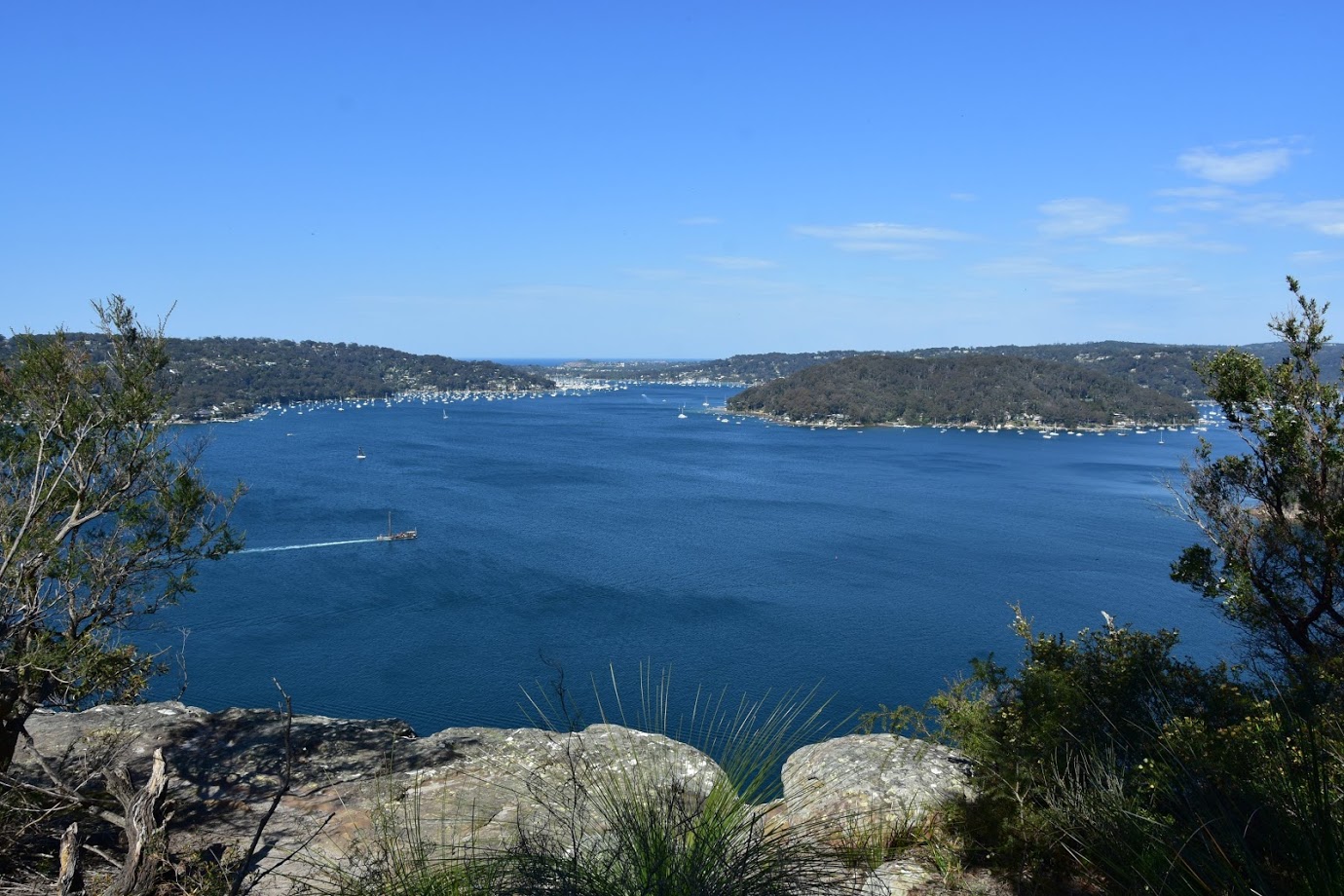
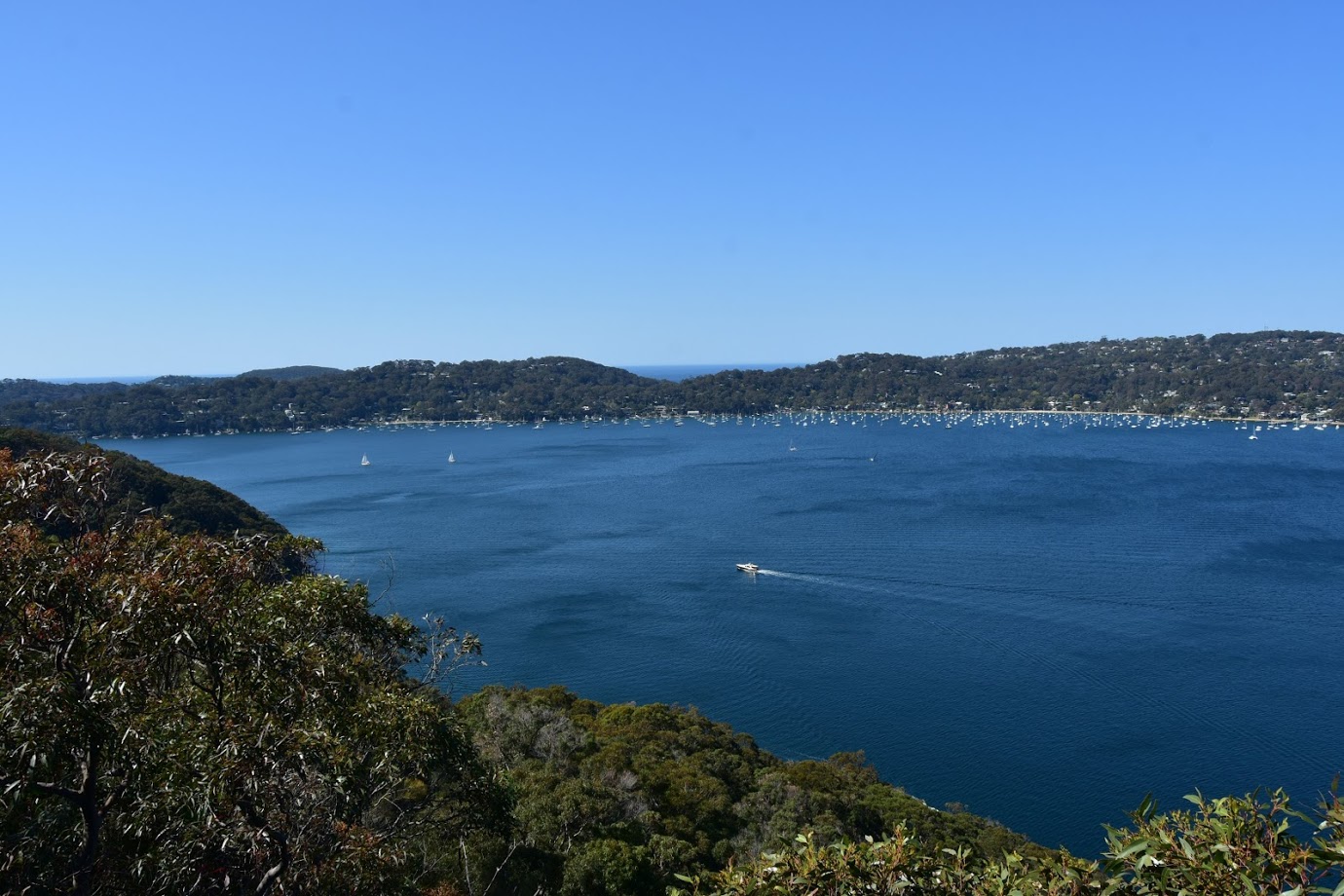
.jpg?timestamp=1599249050886)
.jpg?timestamp=1599249080677)
.jpg?timestamp=1599249111866)
.jpg?timestamp=1599249145859)
.jpg?timestamp=1599249175819)
.jpg?timestamp=1599249206743)
.jpg?timestamp=1599249239837)
.jpg?timestamp=1599249275385)
.jpg?timestamp=1599249314861)
.jpg?timestamp=1599249348963)
.jpg?timestamp=1599249378154)
.jpg?timestamp=1599249413077)
.jpg?timestamp=1599249470470)
.jpg?timestamp=1599249501521)
.jpg?timestamp=1599249535250)
.jpg?timestamp=1599249566652)
.jpg?timestamp=1599249601599)
.jpg?timestamp=1599249638309)
.jpg?timestamp=1599250746230)
.jpg?timestamp=1599249678225)
.jpg?timestamp=1599249719192)
.jpg?timestamp=1599249806721)
.jpg?timestamp=1599249840063)
.jpg?timestamp=1599249879579)
.jpg?timestamp=1599249912743)
.jpg?timestamp=1599249948650)
.jpg?timestamp=1599249986885)
.jpg?timestamp=1599250248043)
.jpg?timestamp=1599250022424)
.jpg?timestamp=1599250054337)
.jpg?timestamp=1599250085259)
.jpg?timestamp=1599250117612)
.jpg?timestamp=1599250160858)
.jpg?timestamp=1599250203727)
